Revive a Car's Dead Battery with These Top Jumper Cables
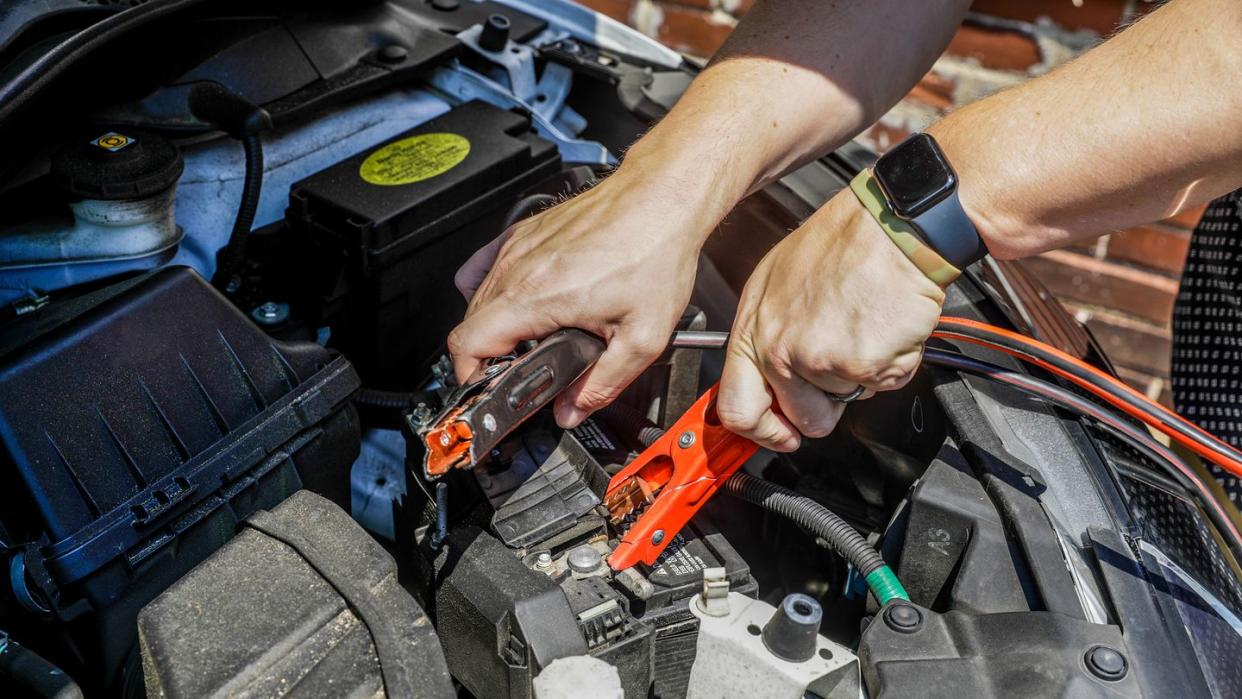
"Hearst Magazines and Yahoo may earn commission or revenue on some items through these links."
A dead car battery can happen to anyone. It can happen to you, too, if you forget to turn off your vehicle’s headlights or you accidentally leave accessories turned on like the car stereo. It usually takes just a quick jumpstart (5 to 10 minutes) to get enough juice to crank the engine and start recharging a dead battery—but you’ll also need another gas-powered vehicle and a good set of jumper cables.
Portable jump starters are another option to revive your dead battery, but here we have focused on the jumper cables. While portable jump starters are convenient and don’t require another vehicle, they must be charged to work, whereas jumper cables are always ready to use—provided there is an appropriate donor vehicle available. To get the job done properly, your jumper cables will need to be of sufficient quality and length, and must be used correctly.
Jumper cables are inexpensive enough that every car owner should have a set, and they’re small enough to join other in-car emergency essentials like a first-aid kit, basic tools, duct tape, and flares. All the jumper cables included here come with a storage bag, an important feature, since cables can be unwieldy and difficult to stow in the small confines of a car.
Best Jumper Cables
Best Overall Jumper Cables: Cartman BC0420K
Best Budget Jumper Cables: Energizer ENB-1012
Best Heavy Duty Jumper Cables: Autogen BC-1G30
Best Jumper Cables Package Deal: Lifeline AAA Premium Road Kit
Best Jumper Cables for the Inexperienced: Horusdy AB001
The Expert: I’ve spent my entire 30-year-plus journalism career testing car technology, electronics and accessories, and cut my automotive teeth wrenching on my own beater vehicles and combing junk yards for spare parts. My dad gave me my first pair of hand-me-down jumper cables and I’ve owned a set ever since. I’ve also learned the hard way that buying cheap jumper cables that don’t last, carry enough current, or are too short aren’t worth it. I always like helping people who don’t have jumper cables—and reminding them that they should own a pair.
What to Look for in Jumper Cables
Cable Gauge
One of the main features to consider with jumper cables is the gauge, or thickness of the wires. The lower the gauge the thicker the cable and the more amperage—the flow electric current through a surface—it can conduct. For most vehicles, you can use 4- to 8-gauge jumper cables. Lower gauges are best for heavy-duty vehicles like trucks and large SUVs, while higher-gauge jumper cables are sufficient for compact cars. Thicker jumper cables may be harder to maneuver and they will take up more space in your vehicle, so weigh the best option before you buy, factoring in cable size and where you will store them.
More for The Road: Best Traction Boards • Best Tire Chains • Best Spray De-Icers • Best Dash Cams
Length
Cable length is a trade-off. While shorter cables can certainly make do in a pinch, you should look for jumper cables that are at least 10 feet long. Here’s why: You probably know where your battery is located, but you never know where the donor car’s battery will be, and some cars place them in the trunk. Longer cables ensure optimal reach between two vehicle’s batteries, but longer cables will take up more space and might be less convenient to store.
Clamps
This small jumper-cable detail makes a big difference. I’ve skimped and bought jumper cables with small clamps and regretted it. Jumper cable clamps are a crucial point of contact to your vehicle and need to be secure for an effective transfer of power. For safety reasons, you don’t want clamps to suddenly pop off while doing a jumpstart, and you definitely won’t want to be fumbling with flimsy clamps in the rain and dark. Some vehicles have small terminals on the side of the battery so you’ll want to be sure the jumper cables you choose can easily connect to them.
Storage
Jumper cables are cumbersome, so getting a set that comes with a storage bag helps keep them tucked tidily in your trunk or rear cargo area. While all the ones recommended in this roundup come with some kind of storage container, some options may not, though this isn't necessarily a dealbreaker. I’ve repurposed reusable cloth shopping bags or nylon cinch sacks to keep jumper cables neatly stored.
Accessories
Some jumper cables come with lights built into the clamps for easier use at night, and others come with a small portable light as well as gloves and a wire brush to clean any corrosion off a battery terminal for good contact. You usually pay more for these additional features, but when you’re dealing with a dead and dirty battery after dark it’s well worth the extra cost.
Safety
Even though a car battery is low voltage (12 volts), you’re working with electricity when jumpstarting a vehicle and a wrong move can create various hazards. Make sure to review any safety procedures and owner’s manuals before using jumper cables. The basics are: red is positive and black is negative. First, you never want the clamps to touch. This will cause dangerous sparks that can potentially ignite hydrogen gas escaping from the battery.
If jumper cables are attached incorrectly—a black terminal to red terminal and vice-versa—in what’s called reverse polarity—the best-case scenario is it will blow a fuse. Worse case, it can destroy a battery or even fry the electronics system of the vehicle being jumpstarted.
How to Use Jumper Cables
There are detailed instructions on how to jumpstart a car here. But here are a few quick tips. After locating the batteries on each vehicle, determine which are the positive (+) and negative (-) terminals. While the positive post may have a red cable attached and the negative a black cable, it's always best to look for a plus or minus sign on the battery itself to determine polarity.
Brush away any corrosion or debris from the posts to get as clean and as solid of a connection as possible. Connect one end of the red clamp to the positive post on the dead battery and connect the other end of the red clamp to the positive post on the battery in the donor vehicle. Then connect the black or negative clamp to the negative terminal on the good battery. Instead of connecting the other negative clamp to the dead battery’s negative post, locate an unpainted engine bolt or metal piece of the vehicle's frame and attach the negative clamp to it for a more secure connection and a safer jumpstart.
Start the functioning vehicle and then try to start the dead vehicle. If the vehicle with the dead battery doesn’t start right away, give it a minute or two, then try again. Once the jump is successful, leave the vehicle with the dead battery running and carefully disconnect the cables, ensuring the clamps don't touch. Keep the vehicle with the dead battery running to give enough time to recharge the drained battery.
How We Selected Jumper Cables
For my recommendations, I relied on my own experience using jumper cables, and I tested the jumper cables on my own 2007 Honda Element that I seldom drive, and which occasionally needs a jumpstart. Additionally, I quizzed my car journalist friends and fellow enthusiasts about their picks and preferences, and scoured online reviews. I included options in a range of prices and sizes—jumper cables for the most frugal commuter to those for the kind of person for whom their car is an extension of their lifestyle.
While jumper cables from familiar brands such as Energizer and Diehard are available, consider the features mentioned above rather than just what’s on the box. Length, gauge, and clamp quality are more important than a recognizable name, and a solid warranty will tell you that the company stands behind its products.
20-Foot (4-Gauge)—BC0420K
It’s hard to go wrong with these all-around, value-priced jumper cables. A patented clamp design easily and snugly grips both top- and side-post batteries, and these are coated with non-conducting rubber for simple and safe use.
These 4-gauge cables have a higher copper content than other cables in general for enhanced conductivity. They're also designed to work in temperatures as low as -25C/-13F. At 20 feet in length, they’re shorter than others included here but can work with larger vehicles. The cables come with a convenient mesh-like storage bag and a three-year warranty.
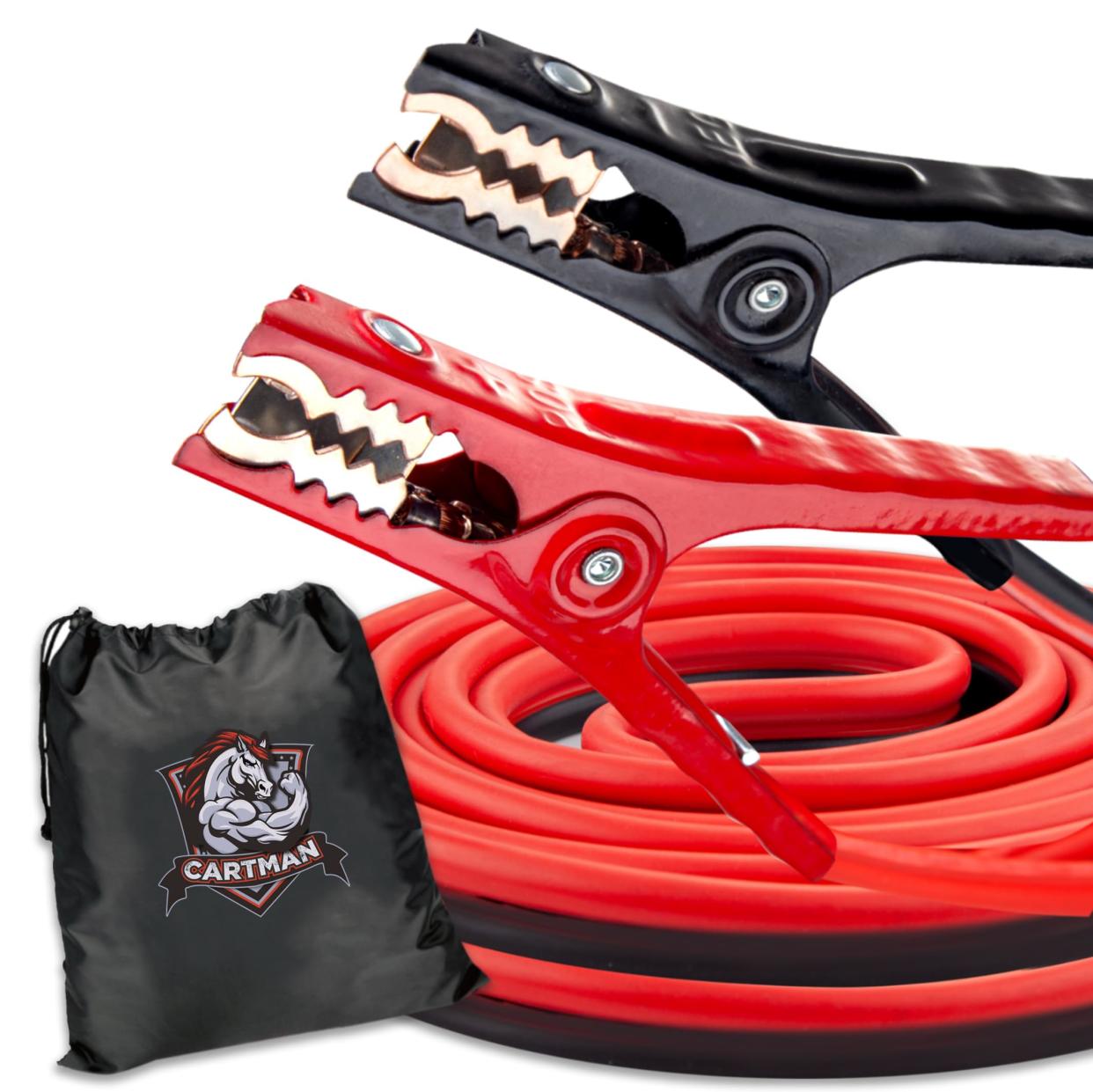
20-Foot (4-Gauge)—BC0420K
amazon.com
$28.99
12-Foot (10-Gauge)—ENB-1012
These low-cost cables from Energizer are only 12 feet long, and at their 10-gauge in thickness, they are the thinnest of all the cables in this roundup, making these better for emergencies rather than long-time use.
The spring-loaded clamps are some of the smallest I tested and are more difficult to open, but they securely connect to battery posts. The cables have a vinyl coating to protect against abrasions, corrosion, nicks, and cuts, and are largely tangle-free. The Energizer jumper cables come with a soft-sided storage bag and have a 2-year warranty.
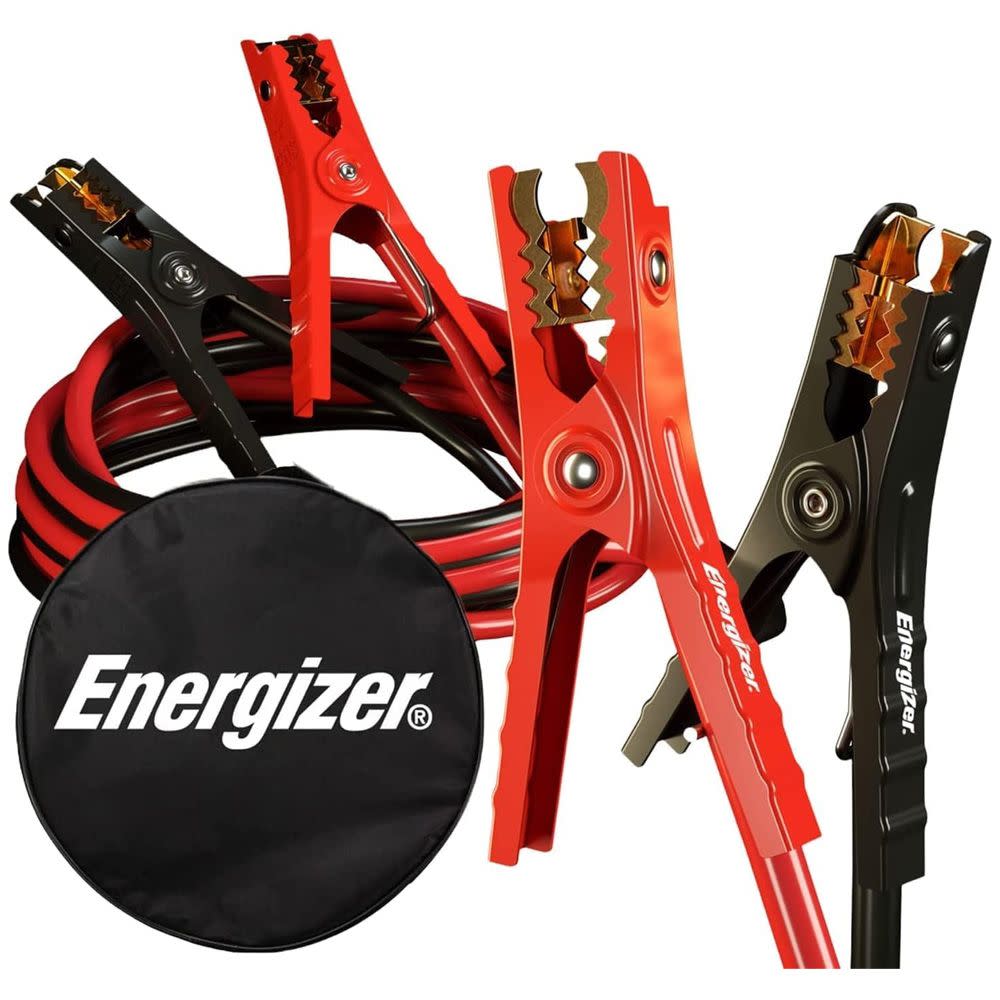
12-Foot (10-Gauge)—ENB-1012
amazon.com
$15.97
30-Foot (1-Gauge)—BC-1G30
If you drive a large vehicle and tend to go on big adventures—which require towing a trailer or traveling off-road—these are the cables you want to carry.
These 1-gauge jumper cables supply up to 900 amps for maximum power transfer, and at 30 feet long, they can reach farther than any of the other jumper cables I tested. For their size and thickness, the cables are flexible and work in temperatures as low as -40 degrees F.
The clamps have 100-percent copper jaws for maximum conductivity, and they securely connect to both top- and side-post batteries. The Autogen BC-1G30 cables come with a pair of gloves and portable LED light that all fit into a convenient soft storage bag.
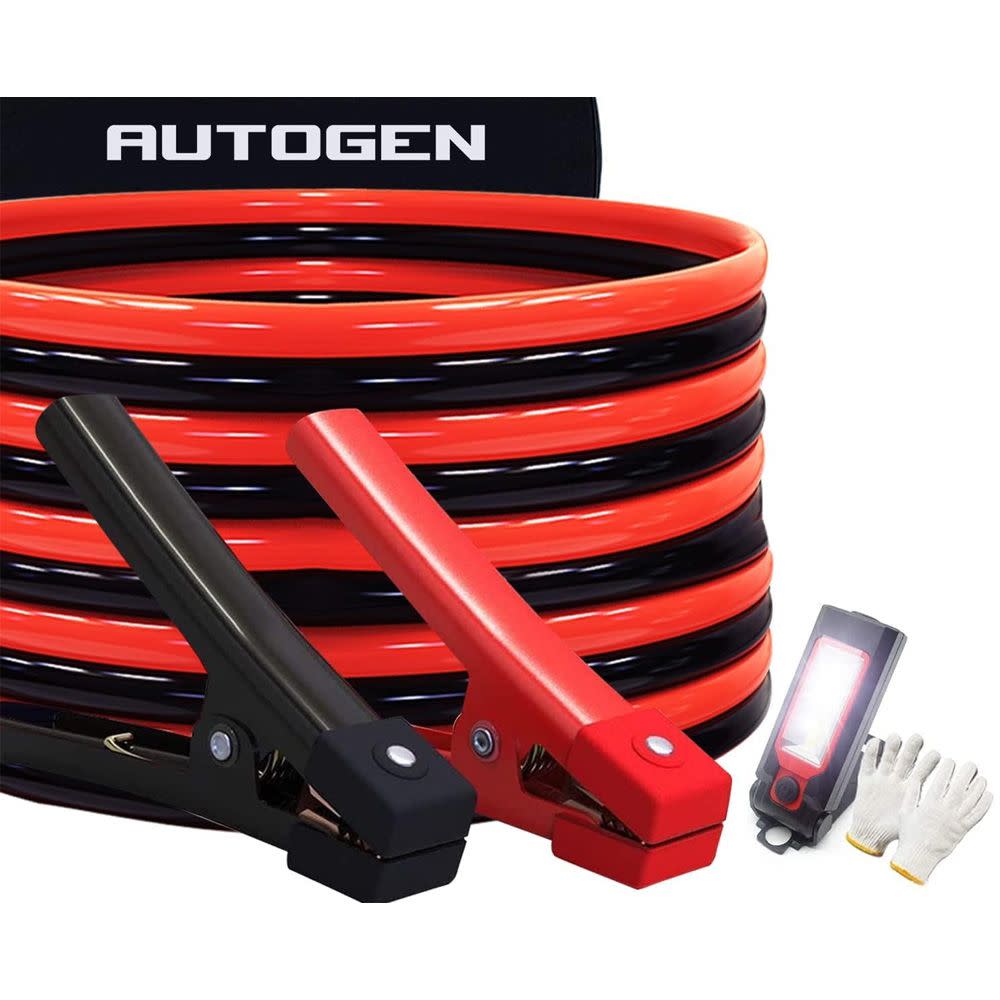
30-Foot (1-Gauge)—BC-1G30
amazon.com
$66.99
AAA Premium Road Kit
Along with having a set of jumper cables, every car owner should have a a roadside emergency kit. This AAA-approved kit covers all the bases and includes basic 8-gauge, 8-foot jumper cables that will get your car started in a pinch.
The kit also comes with an aluminum flashlight and batteries, a 2-in-1 screwdriver, duct tape, an emergency poncho, a shop cloth, five cable ties, 20 bandages, four towelettes, a reusable Ziplock bag, and a AAA membership brochure and accident guidelines booklet—all in a compact storage bag with handles.
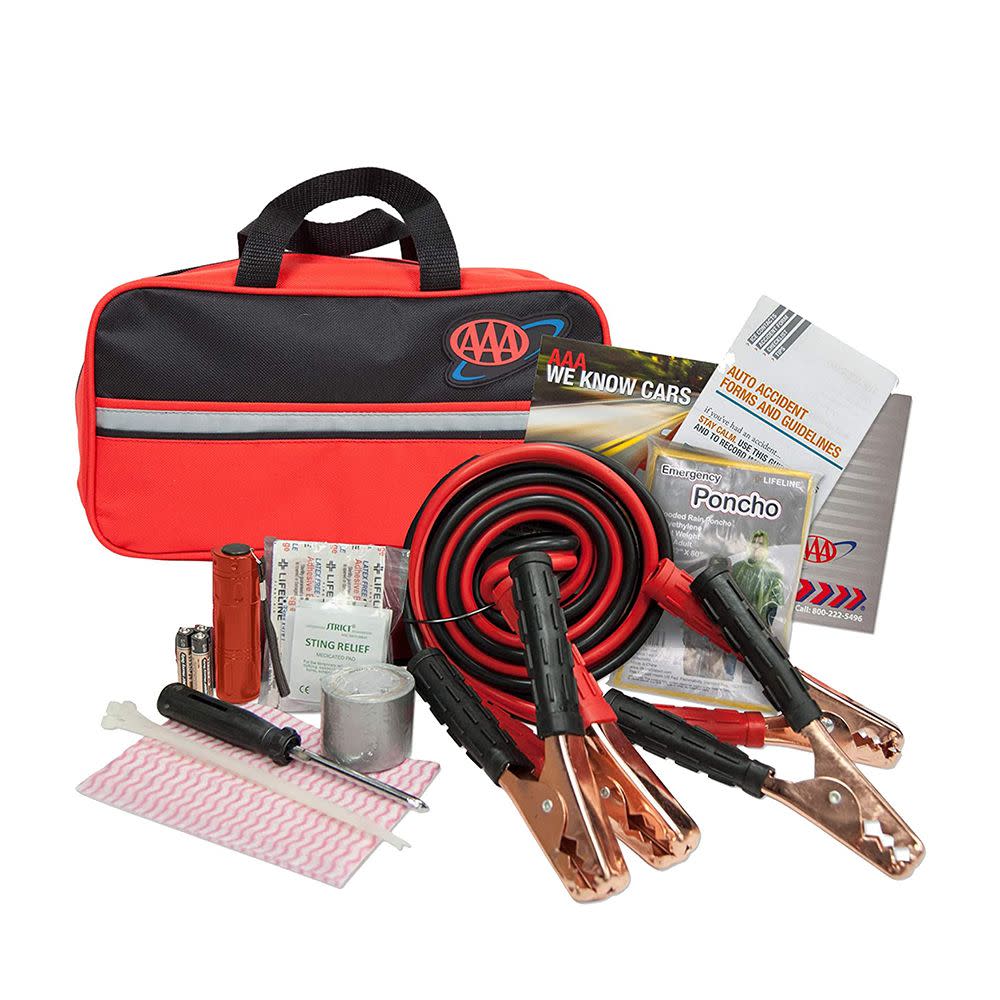
AAA Premium Road Kit
amazon.com
$45.09
25-Foot (1-Gauge)—AB001
Connecting jumper cables between car batteries is straightforward—red/positive to positive and black/negative to negative—and almost all jumper cables are color coded. Still, there’s always a chance of reversing the polarity—and potentially frying your car’s electrical system. The Horusdy jumper cables come with a built-in LED indicator that lights up red if the clamps are incorrectly connected and lights up green if you’re good to go.
At 25-feet long, these cables provide more than adequate reach from one battery to the other, and their 1-gauge thickness passes ample current, making these suitable for larger vehicles. The PVC cables have a thick inner core and are designed to be flexible even in winter temperatures of -40 degrees F. Included with the cables are an LED light with a magnet and a soft-sided carrying case.
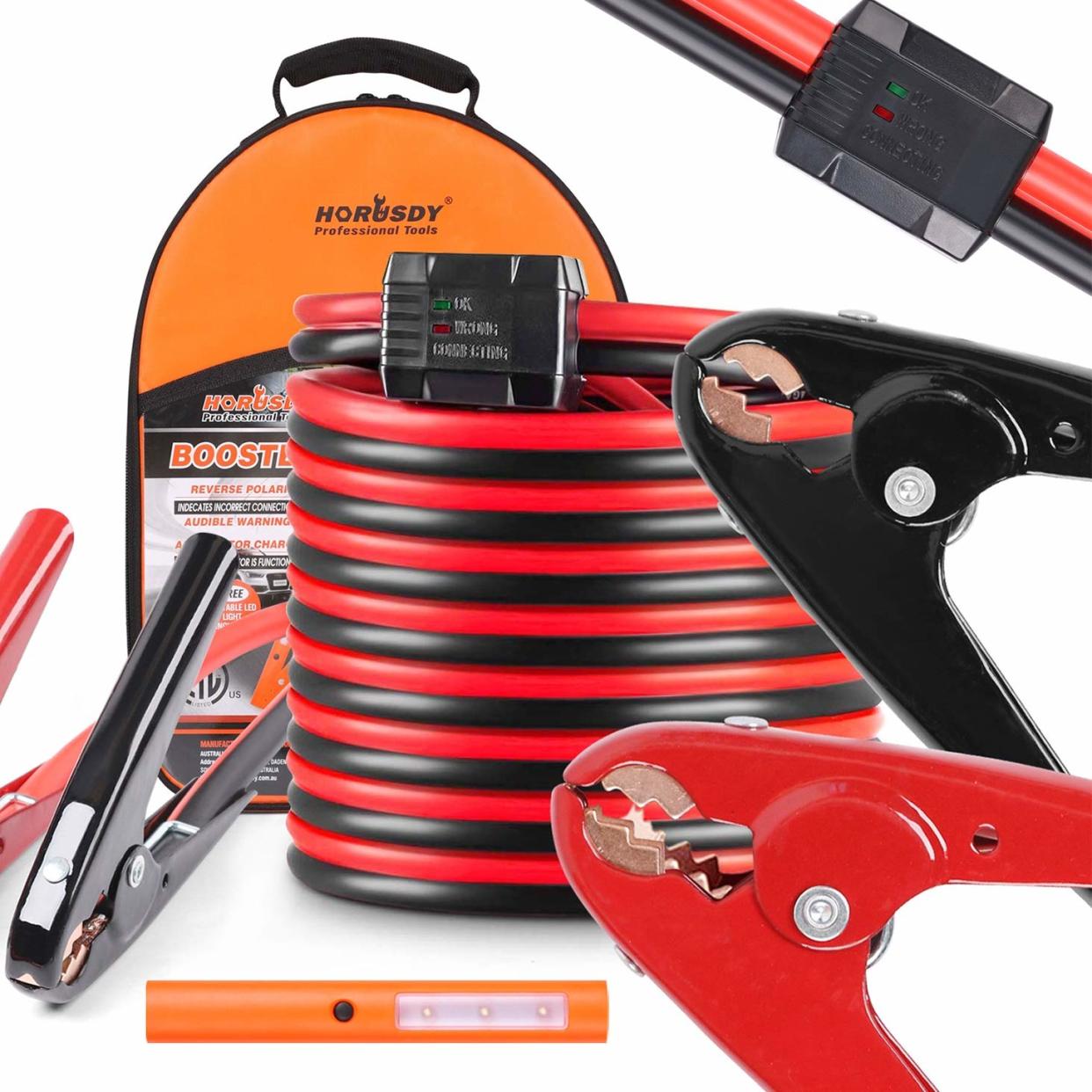
25-Foot (1-Gauge)—AB001
amazon.com
$41.99
16-Foot (6-Gauge) —XH-AZ0001
If you’re stuck with a dead battery after dark, you’ll be glad you have these Aweltec jumper cables with LEDs built into the clamps.
The 6-gauge, 16-foot cables, which are tangle-free, work temperatures from -40F/-40C to 140F/60C. The patented clamps are covered with non-conducting rubber for safety and to protect the copper jaws from damage. They come with a carry bag for easy transport and compact storage, along with a set of gloves, a wire brush, and a five-year warranty.
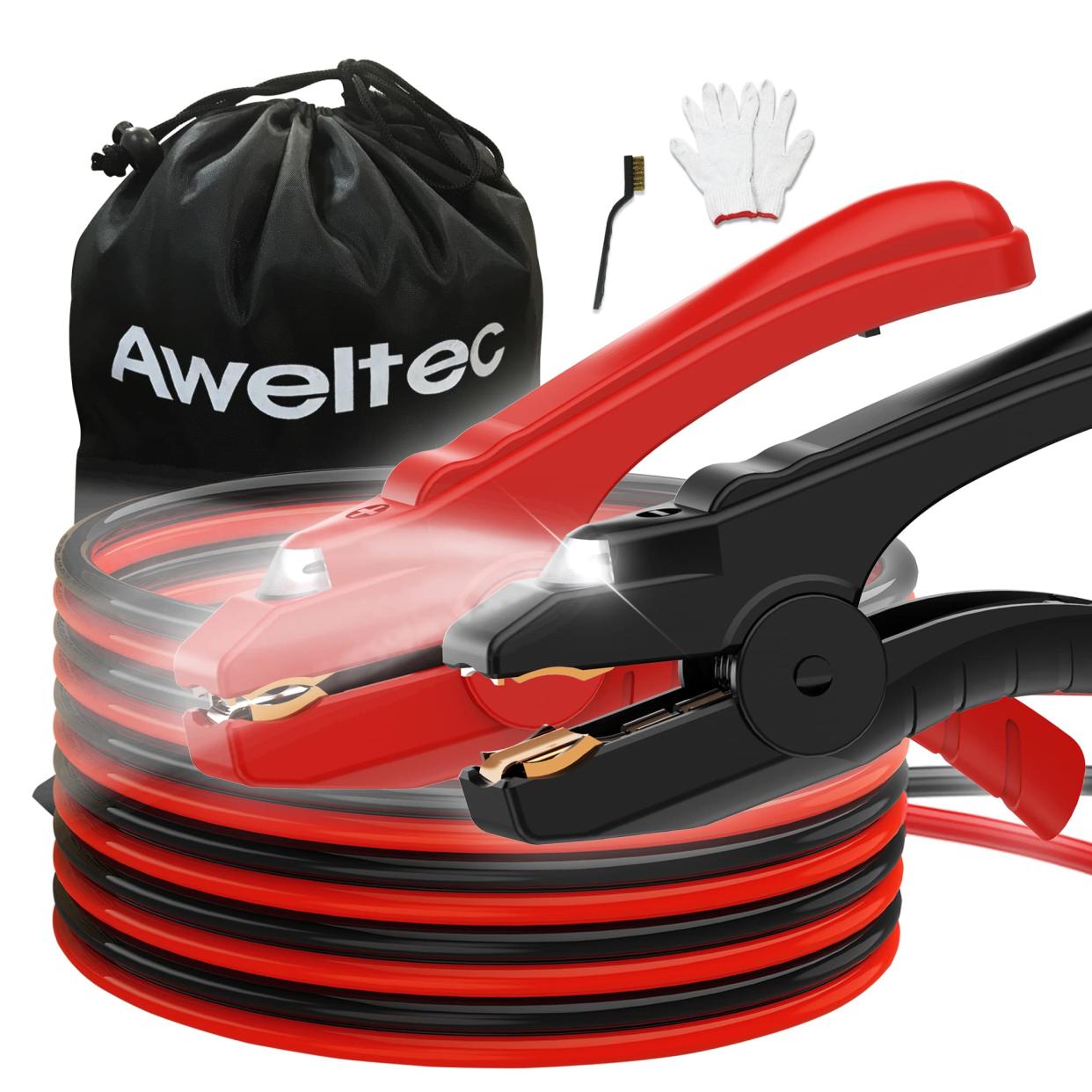
16-Foot (6-Gauge) —XH-AZ0001
amazon.com
$17.99
8-Foot (8-Gauge)—YUA00ACC07
Motorcycles also sometimes need a jump start, and so do ATVs, snowmobiles, jet skis, and other small personal watercraft. The Yuasa cables are a decent choice for owners of these vehicles. Lightweight, at just 1 pound, they’re the lightest jumper cables I tested. Strong, durable, and tangle-resistant, they offer 8-gauge thickness, but are only 8 feet in length.
They have color-coded rubber-grip clamps for convenience and safety, and and come with a small storage bag.
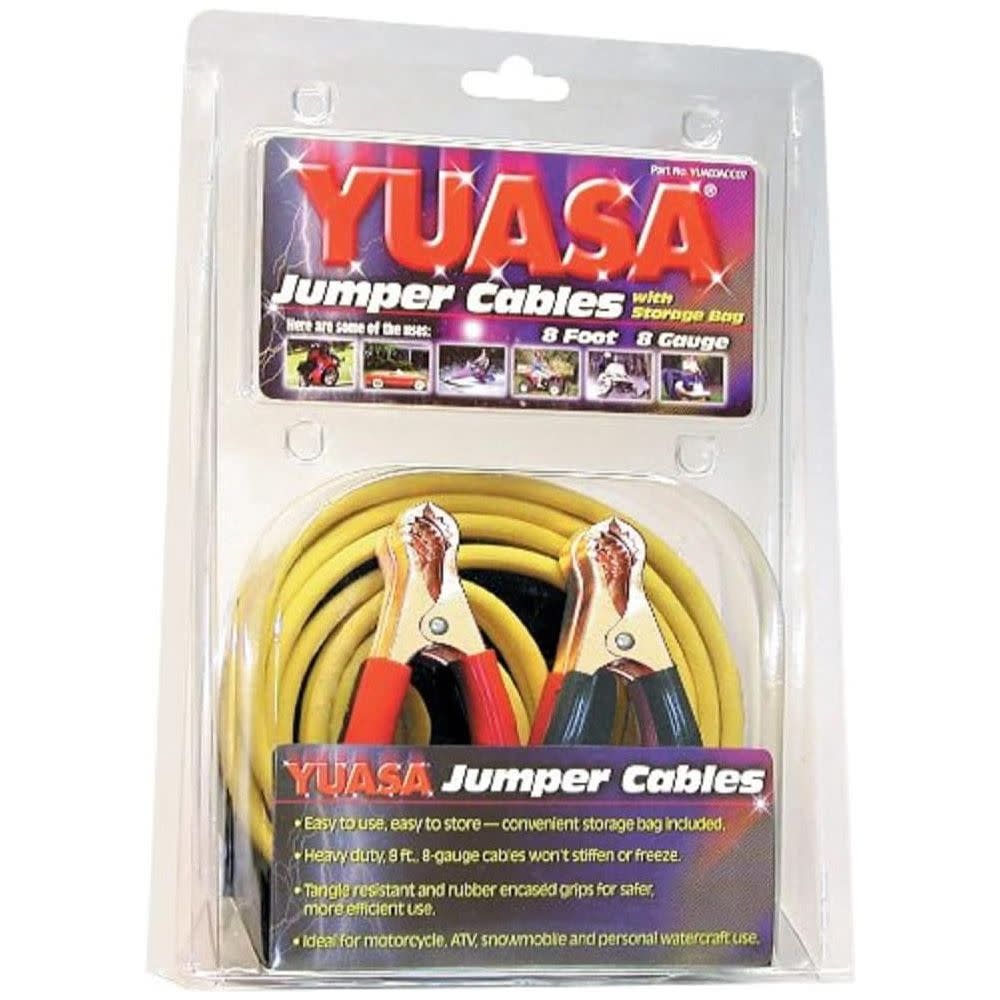
8-Foot (8-Gauge)—YUA00ACC07
amazon.com
$30.65
Expert Doug Newcomb Offers Buying Tips on Jumper Cables
Does the type of car matter—what if you have a hybrid or EV?
Any internal-combustion-engine (ICE) vehicle can be jumpstarted, even hybrids that have a battery that assists the ICE engine to improve gas mileage. An electric vehicle (EV) can also be jumpstarted but it’s a different scenario since juice will be going to its smaller 12-volt battery, not it’s large “traction” battery that powers the vehicle’s electric motor.
An EV’s 12-volt battery does the same job as one in an ICE car, powering accessories such as lights and electronics when the electric motor is off. It also powers an onboard computer that runs certain vehicle systems and is needed to operate the electric car's motor. Jumpstarting an EV’s 12-volt battery is like jumpstarting an ICE vehicle, except the EV has to be unplugged from charging and the vehicle providing the jump must have a 12-volt battery with a negative ground system, which is common.
If you own a hybrid, plug-in hybrid, or fully electric vehicle, consult the owner's manual regarding jump starting it with another vehicle or using your vehicle to start another, as there could be specialized precautions to take into consideration.
What if my battery is in the trunk?
It’s the same jumpstart procedure described above, although a trunk-mounted battery may make it more difficult to get to the terminals for a good connection. Your owner's manual may direct you on how to best conduct a jump-start.
What are some of the extras I might want?
You don’t really need them, but all things being equal, added features like a carrying case, a pair of gloves, LED lights, and a wire brush may make one set of jumper cables a better value than others.
When is it time to look for a new pair of jumper cables?
Immediately replace jumper cables if the insulation is worn or the cables break and if the clamps are not connecting to battery terminals properly or are damaged.
What if jumpstarting my car doesn’t work?
Then you probably have another and potentially bigger issue than just a dead battery. The cause could be as simple as a bad connection or a bad battery or something more complex, like a defective alternator or starter motor.

You Might Also Like
